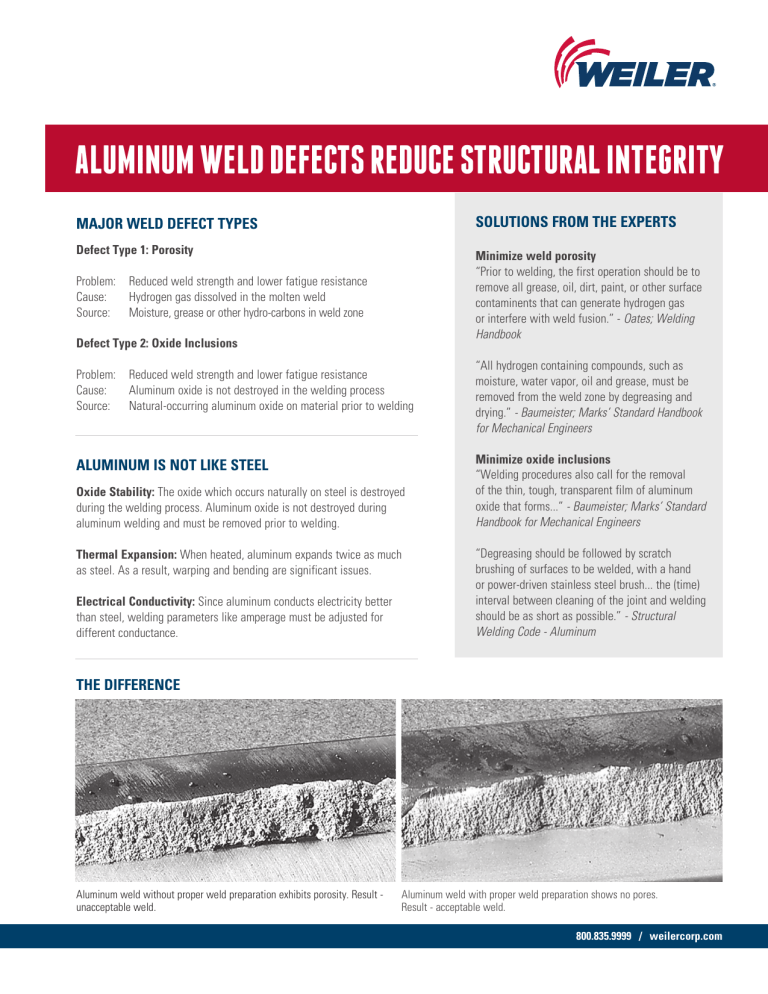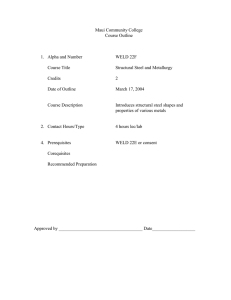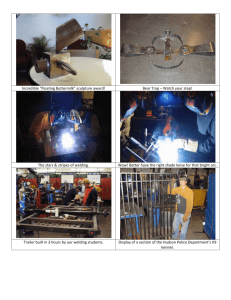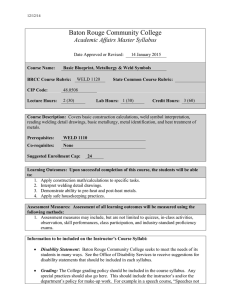
ALUMINUM WELD DEFECTS REDUCE STRUCTURAL INTEGRITY
MAJOR WELD DEFECT TYPES
SOLUTIONS FROM THE EXPERTS
Defect Type 1: Porosity
Minimize weld porosity
“Prior to welding, the first operation should be to
remove all grease, oil, dirt, paint, or other surface
contaminents that can generate hydrogen gas
or interfere with weld fusion.” - Oates; Welding
Handbook
Problem: Reduced weld strength and lower fatigue resistance
Cause:
Hydrogen gas dissolved in the molten weld
Source: Moisture, grease or other hydro-carbons in weld zone
Defect Type 2: Oxide Inclusions
Problem: Reduced weld strength and lower fatigue resistance
Cause:
Aluminum oxide is not destroyed in the welding process
Source: Natural-occurring aluminum oxide on material prior to welding
ALUMINUM IS NOT LIKE STEEL
Oxide Stability: The oxide which occurs naturally on steel is destroyed
during the welding process. Aluminum oxide is not destroyed during
aluminum welding and must be removed prior to welding.
Thermal Expansion: When heated, aluminum expands twice as much
as steel. As a result, warping and bending are significant issues.
Electrical Conductivity: Since aluminum conducts electricity better
than steel, welding parameters like amperage must be adjusted for
different conductance.
“All hydrogen containing compounds, such as
moisture, water vapor, oil and grease, must be
removed from the weld zone by degreasing and
drying.” - Baumeister; Marks’ Standard Handbook
for Mechanical Engineers
Minimize oxide inclusions
“Welding procedures also call for the removal
of the thin, tough, transparent film of aluminum
oxide that forms...” - Baumeister; Marks’ Standard
Handbook for Mechanical Engineers
“Degreasing should be followed by scratch
brushing of surfaces to be welded, with a hand
or power-driven stainless steel brush... the (time)
interval between cleaning of the joint and welding
should be as short as possible.” - Structural
Welding Code - Aluminum
THE DIFFERENCE
Aluminum weld without proper weld preparation exhibits porosity. Result unacceptable weld.
Aluminum weld with proper weld preparation shows no pores.
Result - acceptable weld.
800.835.9999 / weilercorp.com
THE GOAL: HIGHEST QUALITY ALUMINUM WELDS
DEGREASED STAINLESS PRODUCTS FOR WELD PREP
A
B
C
“Thick aluminum oxide should be removed with a
power-driven stainless steel brush...”
- Structural Welding Code - Aluminum
Bevel knot brush
Knot end brush
Crimped end brush
D
E
F
All of Weiler’s brushes for aluminum
weld preparation are designed to provide maximum
cleaning efficiency without depositing grease or
oil in the work area.
Small hand
wire scratch brush
For best results, “brushes should be used
with light pressure to avoid burnishing
the aluminum surface and entrapping
oxide particles.” - Oates; Welding Handbook
G
Knot wheel brush
Crimped wheel brush
Hand wire
scratch brush
NOTE:Specialty applications for the above products are shown in the schematics below. Products F & G are used in
a wide variety of general purpose applications. For specific product/application information, contact Weiler.
B
A&C
D&E
A
PRODUCTS FOR ALUMINUM GRINDING
CAUTION
Big Cat™ discs are ideal
Resin Fiber discs
for use on flat surfaces.
are a general purpose
They are especially wellgrinding tool.
suited for smoothing edges
following cutting operations.
GS0004 / ©2015 Weiler Corporation. All Rights Reserved.
AL-tra CUT™ discs are
designed to prevent loading
in applications where weld
blending is required. AL-tra
CUT discs should not be used
during weld preparation.
“Grinding or sanding with wheels or discs
can be done with proper materials, although
it is easy to imbed abrasive particles in the
aluminum surface that may result in
unacceptable inclusions in the weld.”
Oates; Welding Handbook
800.835.9999 / weilercorp.com






